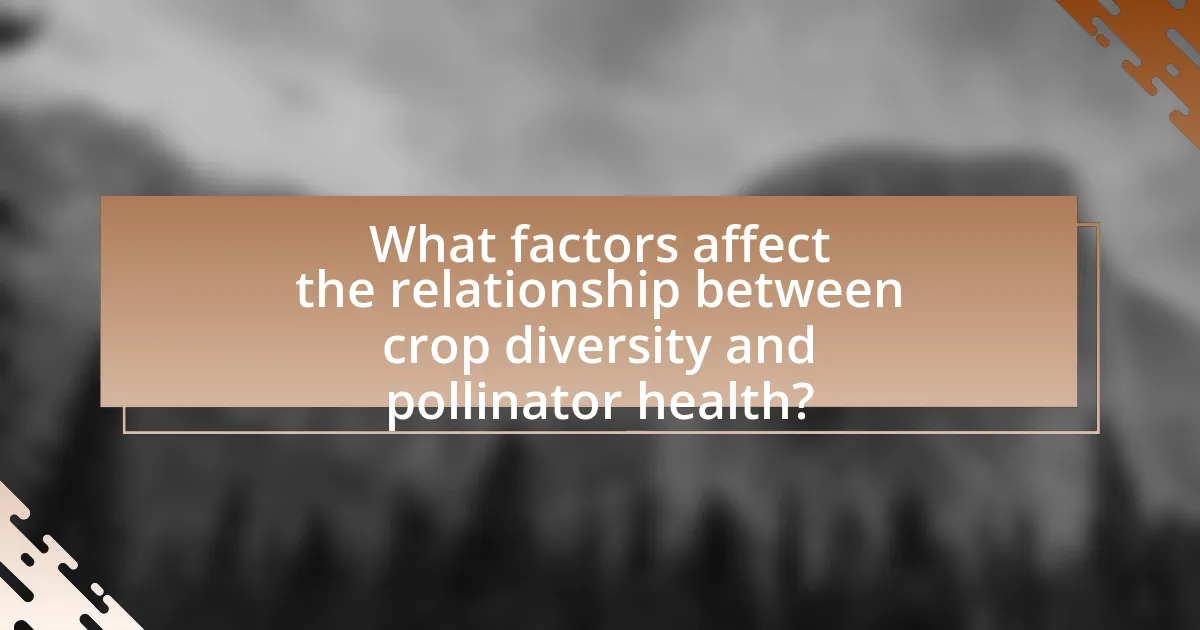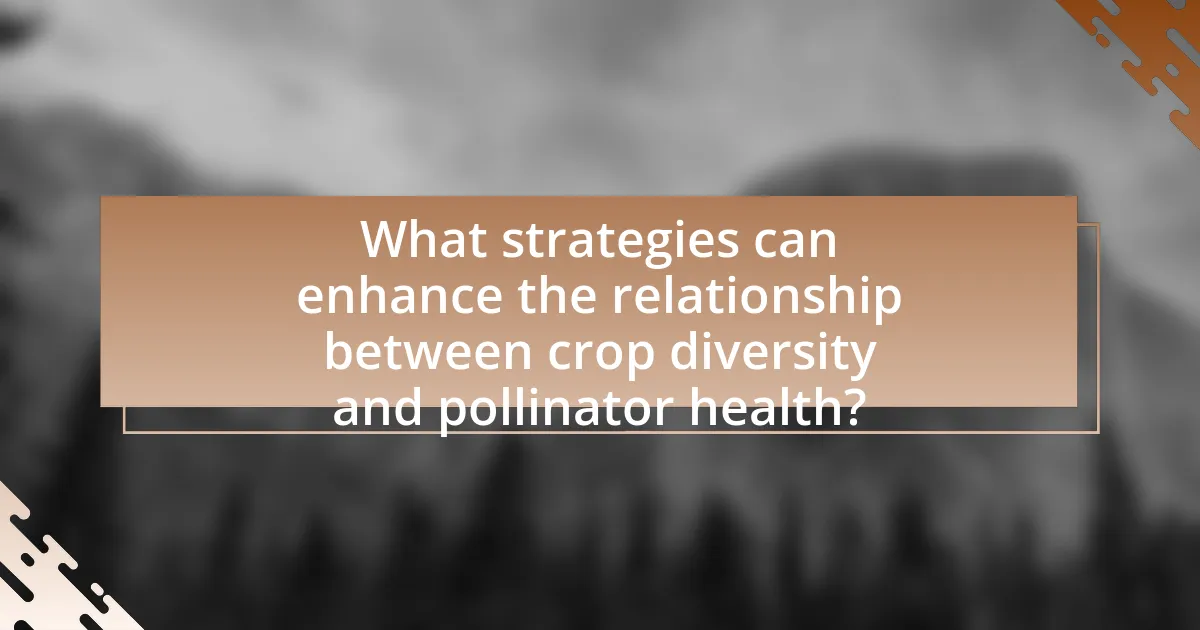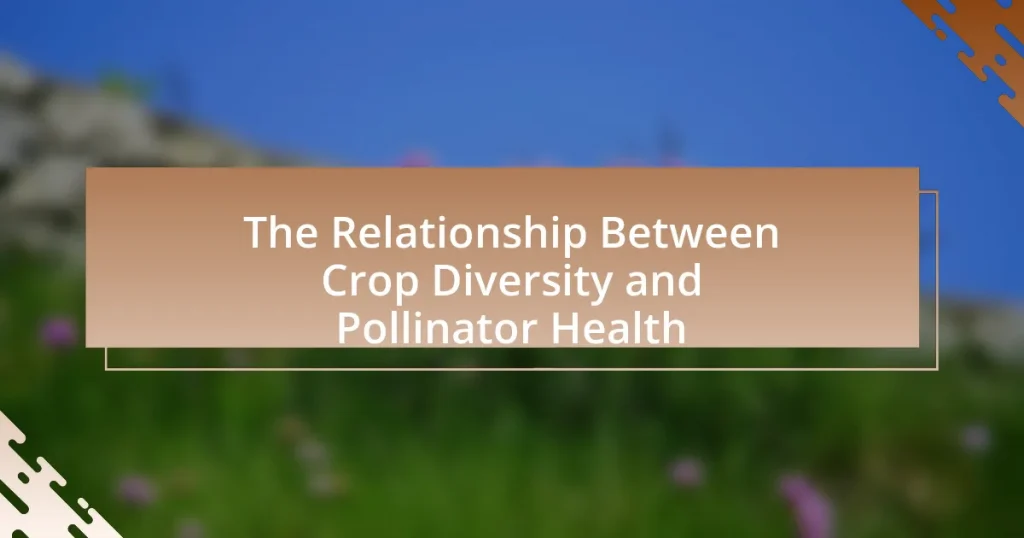The article examines the critical relationship between crop diversity and pollinator health, highlighting how diverse agricultural systems enhance pollinator populations by providing varied food sources and habitats. Research indicates that farms with higher crop diversity can support significantly more pollinator species compared to monoculture systems, which in turn improves pollination services and crop yields. The article also discusses specific crops that benefit different pollinator species, the impact of agricultural practices on biodiversity, and the importance of maintaining pollinator health for food security. Additionally, it outlines strategies for farmers and policymakers to promote sustainable practices that support both crop diversity and pollinator well-being.

What is the relationship between crop diversity and pollinator health?
Crop diversity positively influences pollinator health by providing a variety of food sources and habitats. Diverse crops attract a wider range of pollinators, which enhances their nutrition and supports their populations. Research indicates that farms with higher crop diversity can sustain more abundant and diverse pollinator communities, leading to improved pollination services. For example, a study published in the journal “Ecological Applications” found that agricultural landscapes with diverse crops had 50% more pollinator species compared to monoculture systems, demonstrating the critical link between crop diversity and the health of pollinator populations.
How does crop diversity influence pollinator populations?
Crop diversity positively influences pollinator populations by providing a variety of food sources and habitats. Diverse crops attract a wider range of pollinators, such as bees and butterflies, which rely on different types of flowers for nectar and pollen. Research indicates that farms with higher crop diversity can support up to 50% more pollinator species compared to monoculture systems. This increase in species richness enhances pollinator health and resilience, as diverse environments reduce competition for resources and provide continuous blooming periods throughout the growing season. Studies, such as those conducted by Kremen et al. (2007) in “Pollination Services and Biodiversity in Agricultural Landscapes,” demonstrate that increased floral diversity leads to improved pollination services, ultimately benefiting crop yields and ecosystem stability.
What specific types of crops support different pollinator species?
Specific types of crops that support different pollinator species include wildflowers, fruit trees, and legumes. Wildflowers, such as sunflowers and clover, attract a variety of bees and butterflies due to their abundant nectar and pollen. Fruit trees like apple and cherry provide essential resources for pollinators, particularly honeybees and bumblebees, during their blooming periods. Legumes, including alfalfa and peas, are also beneficial as they offer high-quality forage for various bee species. Research indicates that diverse crop systems enhance pollinator abundance and health, as demonstrated in studies showing that farms with a mix of these crops have higher pollinator visitation rates and improved crop yields.
How does the availability of diverse floral resources affect pollinator foraging behavior?
The availability of diverse floral resources significantly enhances pollinator foraging behavior by providing a wider range of food sources, which increases foraging efficiency and overall pollinator health. Research indicates that when pollinators, such as bees, have access to a variety of flowers, they exhibit increased foraging activity and preference for certain floral traits, which can lead to higher rates of pollination. A study published in the journal “Ecology Letters” by Potts et al. (2010) found that diverse floral landscapes support greater pollinator abundance and diversity, ultimately improving crop yields. This relationship underscores the importance of maintaining floral diversity in agricultural systems to optimize pollinator services.
Why is pollinator health important for agricultural systems?
Pollinator health is crucial for agricultural systems because it directly impacts crop yields and food production. Healthy pollinators, such as bees and butterflies, enhance the pollination of many crops, leading to increased fruit and seed set. For instance, studies show that approximately 75% of the world’s food crops depend on animal pollination, which underscores the vital role of pollinators in ensuring food security. Additionally, diverse crop systems can support a wider range of pollinators, promoting ecosystem resilience and stability. Therefore, maintaining pollinator health is essential for sustainable agricultural practices and maximizing agricultural productivity.
What role do pollinators play in crop production?
Pollinators are essential for crop production as they facilitate the fertilization of flowering plants, leading to the development of fruits and seeds. Approximately 75% of the world’s food crops depend on animal pollination, which significantly enhances crop yields and quality. Studies indicate that crops such as apples, almonds, and blueberries rely heavily on pollinators, with the economic value of pollination services estimated at over $200 billion globally. This underscores the critical role that pollinators play in ensuring food security and agricultural sustainability.
How does pollinator decline impact food security?
Pollinator decline significantly threatens food security by reducing the availability of crops that rely on these species for pollination. Approximately 75% of the world’s food crops depend on animal pollination, which includes fruits, vegetables, and nuts. The decline in pollinator populations, driven by habitat loss, pesticide use, and climate change, leads to lower yields and reduced crop diversity. For instance, studies indicate that a 30% decline in pollinator populations can result in a 10-20% decrease in crop production, directly impacting food availability and prices. This reduction in crop diversity not only limits food options but also affects nutritional quality, exacerbating food insecurity globally.

What factors affect the relationship between crop diversity and pollinator health?
Crop diversity positively influences pollinator health through several key factors, including habitat availability, resource abundance, and ecosystem stability. Increased crop diversity provides a variety of flowering plants, which enhances food resources for pollinators, leading to improved nutrition and reproductive success. Studies have shown that landscapes with higher plant diversity support greater pollinator populations and diversity, as evidenced by research conducted by Kremen et al. (2007) in “Pollination and Ecosystem Services,” which found that diverse agricultural systems can sustain more robust pollinator communities. Additionally, diverse crops can create more resilient ecosystems, reducing the vulnerability of pollinators to pests and diseases, thereby promoting overall pollinator health.
How do agricultural practices influence crop diversity?
Agricultural practices significantly influence crop diversity by determining the types of crops cultivated and the methods used for their production. Practices such as monoculture, which involves growing a single crop over a large area, reduce genetic diversity and can lead to increased vulnerability to pests and diseases. Conversely, polyculture and crop rotation enhance biodiversity by promoting a variety of species, which can improve ecosystem resilience and health. Research indicates that diverse cropping systems can support a wider range of pollinators, as they provide varied resources and habitats, ultimately benefiting both crop yields and pollinator populations. For instance, a study published in “Agriculture, Ecosystems & Environment” by Kremen et al. (2007) found that farms with higher crop diversity had increased pollinator visitation rates, demonstrating the direct link between agricultural practices and crop diversity.
What are the effects of monoculture on pollinator health?
Monoculture negatively impacts pollinator health by reducing habitat diversity and food availability. This farming practice leads to a lack of varied flowering plants, which are essential for sustaining diverse pollinator populations. Research indicates that areas dominated by monoculture crops, such as corn or soybeans, provide limited nutritional resources for pollinators, resulting in decreased foraging efficiency and lower reproductive success. A study published in the journal “Ecological Applications” by Kremen et al. (2007) found that agricultural landscapes with higher crop diversity support greater pollinator abundance and diversity, highlighting the detrimental effects of monoculture on pollinator health.
How can sustainable farming practices enhance crop diversity?
Sustainable farming practices enhance crop diversity by promoting ecological balance and reducing reliance on monocultures. Techniques such as crop rotation, intercropping, and organic farming improve soil health and create habitats for various species, which in turn supports a wider range of crops. Research indicates that farms employing sustainable methods can increase plant species richness by up to 30%, fostering resilience against pests and diseases. This diversity not only benefits the crops themselves but also supports pollinator health, as varied plant life provides essential resources for pollinators, leading to improved agricultural productivity.
What environmental factors impact both crop diversity and pollinator health?
Environmental factors that impact both crop diversity and pollinator health include habitat availability, pesticide use, and climate change. Habitat availability influences the variety of crops that can be cultivated and the presence of diverse pollinator species, as diverse habitats support a wider range of plants and insects. Pesticide use negatively affects pollinator populations, which in turn can reduce crop yields and diversity due to decreased pollination. Climate change alters growing conditions and flowering times, affecting both crop production and the synchronization with pollinator activity. Studies have shown that regions with higher habitat diversity support greater pollinator abundance and crop yields, highlighting the interconnectedness of these environmental factors.
How do climate change and habitat loss affect pollinator populations?
Climate change and habitat loss significantly reduce pollinator populations by altering their environments and food sources. Rising temperatures and changing precipitation patterns disrupt the timing of flowering plants, leading to mismatches between pollinators and their food availability. For instance, a study published in the journal “Nature” found that climate change has shifted the flowering times of plants, which can negatively impact pollinators that rely on these plants for sustenance. Additionally, habitat loss due to urbanization and agricultural expansion diminishes the natural environments where pollinators thrive, further decreasing their populations. Research indicates that habitat fragmentation can lead to reduced genetic diversity among pollinators, making them more vulnerable to extinction.
What is the significance of landscape diversity in supporting pollinators?
Landscape diversity is significant in supporting pollinators because it provides a variety of habitats and food sources essential for their survival and reproduction. Diverse landscapes, which include a mix of crops, wildflowers, and natural habitats, enhance the availability of nectar and pollen, crucial for pollinator nutrition. Research indicates that areas with higher plant diversity can support greater numbers of pollinator species, as they offer different resources throughout the growing season. For instance, a study published in the journal “Ecology Letters” found that agricultural landscapes with diverse floral resources increased pollinator abundance and diversity, leading to improved crop yields. This evidence underscores the critical role of landscape diversity in maintaining healthy pollinator populations, which are vital for ecosystem functioning and agricultural productivity.

What strategies can enhance the relationship between crop diversity and pollinator health?
Enhancing the relationship between crop diversity and pollinator health can be achieved through several strategies, including the implementation of diverse planting systems, habitat restoration, and reduced pesticide use. Diverse planting systems, such as intercropping and polyculture, provide a variety of floral resources and habitats that support a wider range of pollinator species. Research indicates that farms with higher crop diversity can increase pollinator abundance and diversity, leading to improved pollination services (Kremen et al., 2007, “Pollination Services Improve Crop Quality, Yield, and Economic Value,” PLOS ONE).
Habitat restoration, such as creating wildflower strips and maintaining hedgerows, can further enhance pollinator health by providing nesting sites and foraging resources. Studies show that these habitats can significantly increase pollinator populations and their activity levels in adjacent crop fields (Blaauw and Isaacs, 2014, “Flower Planting Increases Wild Bee Abundance and Seed Set in Crops,” Ecological Applications).
Additionally, reducing pesticide use, particularly neonicotinoids, is crucial for protecting pollinator health. Evidence suggests that exposure to these chemicals can harm pollinator populations and disrupt their foraging behavior (Goulson et al., 2015, “Bee Declines Driven by Combined Stress from Parasites, Pesticides, and Lack of Flowers,” Science). Implementing integrated pest management (IPM) practices can help minimize pesticide impacts while maintaining crop yields.
How can farmers implement practices that promote both crop diversity and pollinator health?
Farmers can implement practices that promote both crop diversity and pollinator health by adopting agroecological methods such as intercropping, cover cropping, and creating pollinator habitats. Intercropping involves planting different crops in proximity, which enhances biodiversity and provides varied food sources for pollinators. Cover cropping, which includes planting crops like clover or vetch during off-seasons, improves soil health and offers additional forage for pollinators. Additionally, establishing hedgerows, wildflower strips, and maintaining natural habitats around fields can provide essential nesting sites and food resources for pollinators, thereby supporting their populations. Research indicates that farms with higher crop diversity and dedicated pollinator habitats can experience increased yields and improved ecosystem services, demonstrating the interconnected benefits of these practices.
What are the benefits of planting cover crops for pollinator support?
Planting cover crops provides essential benefits for pollinator support by enhancing habitat diversity and food availability. Cover crops, such as clover and buckwheat, produce flowers that attract various pollinators, including bees and butterflies, thereby increasing pollinator populations. Research indicates that diverse cover crops can improve the overall health of pollinator communities by offering a continuous bloom throughout the growing season, which is crucial for sustaining pollinator activity. Additionally, studies show that fields with cover crops can increase the abundance of beneficial insects, leading to improved crop yields and ecosystem resilience.
How can farmers create pollinator-friendly habitats within agricultural landscapes?
Farmers can create pollinator-friendly habitats within agricultural landscapes by incorporating diverse flowering plants, establishing hedgerows, and implementing cover crops. Diverse flowering plants provide essential nectar and pollen resources, which are crucial for pollinator survival and reproduction. Research indicates that fields with a variety of flowering species can support higher pollinator diversity and abundance, enhancing crop yields. Additionally, hedgerows serve as vital corridors for pollinators, offering shelter and food sources, while cover crops can improve soil health and provide habitat during off-seasons. Studies show that these practices not only benefit pollinators but also contribute to overall agricultural productivity and ecosystem resilience.
What role do policymakers play in supporting crop diversity and pollinator health?
Policymakers play a crucial role in supporting crop diversity and pollinator health by implementing regulations and incentives that promote sustainable agricultural practices. They can establish policies that encourage the cultivation of diverse crops, which enhances habitat for pollinators and improves ecosystem resilience. For instance, the European Union’s Common Agricultural Policy includes measures that support biodiversity through agri-environmental schemes, which incentivize farmers to adopt practices that benefit pollinator populations. Additionally, policymakers can fund research initiatives aimed at understanding the relationship between crop diversity and pollinator health, thereby informing future agricultural strategies. These actions collectively contribute to maintaining healthy ecosystems that are vital for food security and biodiversity.
What policies can encourage sustainable agricultural practices?
Policies that can encourage sustainable agricultural practices include implementing financial incentives for farmers who adopt eco-friendly methods, such as crop rotation and organic farming. These incentives can take the form of subsidies or tax breaks, which have been shown to increase the adoption of sustainable practices. For instance, a study by the USDA found that farms receiving financial support for sustainable practices increased their crop diversity, which in turn enhanced pollinator health and biodiversity. Additionally, regulations that promote integrated pest management and restrict harmful pesticides can further support sustainable agriculture by protecting pollinator populations.
How can community initiatives promote awareness of pollinator conservation?
Community initiatives can promote awareness of pollinator conservation by organizing educational programs and events that highlight the importance of pollinators in agriculture and ecosystems. These initiatives often include workshops, community gardens, and local campaigns that engage residents in hands-on activities, such as planting pollinator-friendly plants. Research indicates that community involvement can significantly increase knowledge and positive attitudes towards pollinator conservation, as seen in studies where local outreach programs led to a 30% increase in public awareness about the role of pollinators in food production. By fostering a sense of community responsibility and providing accessible information, these initiatives effectively raise awareness and encourage sustainable practices that benefit both pollinators and crop diversity.
What are practical tips for farmers to improve crop diversity and support pollinators?
Farmers can improve crop diversity and support pollinators by implementing intercropping, planting cover crops, and creating pollinator habitats. Intercropping involves growing different crops in proximity, which enhances biodiversity and provides varied food sources for pollinators. Planting cover crops, such as clover or vetch, during off-seasons can improve soil health and offer additional forage for pollinators. Establishing pollinator habitats, like wildflower strips or hedgerows, increases the availability of nectar and pollen, crucial for pollinator survival. Research indicates that farms with diverse crops and dedicated pollinator habitats can see a significant increase in pollinator populations, which in turn boosts crop yields and ecosystem health.










